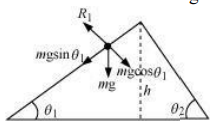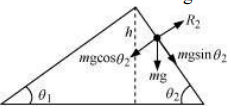(a)Mass of the sphere = m
Height of the plane = h
The velocity of the sphere at the bottom of the plane = v
At the top of the plane, the total energy of the sphere = Potential energy = mgh
At the bottom of the plane, the sphere has both translational and rotational kinetic energies.
Hence, total energy =
Using the law of conservation of energy,
...(i)
For a solid sphere, the moment of inertia about its center,
Hence, equation (i) becomes:
Therefore, the velocity at the bottom remains the same from whichever inclined plane the sphere is rolled.
(b),(c)
Consider two inclined planes with inclinations and , related as: <
The acceleration produced in the sphere when it rolls down the plane inclined at is,
g sin
The various forces acting on the sphere are shown in the following figure.
is the normal reaction to the sphere.
Similarly, the acceleration produced in the sphere when it rolls down the plane inclined at is,
= g sin
The various forces acting on the sphere are shown in the following figure.
is the normal reaction to the sphere.
Initial velocity, u = 0
Final velocity, v = Constant
Using the first equation of motion, we can obtain the time of roll as:
v = u + at
From equations (ii) and (iii), we get:
Hence, the sphere will take a longer time to reach the bottom of the inclined plane having a smaller inclination.


